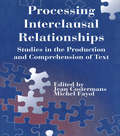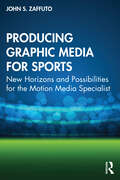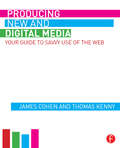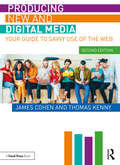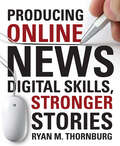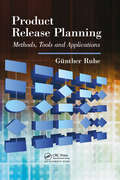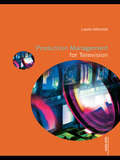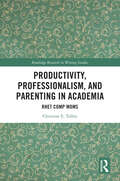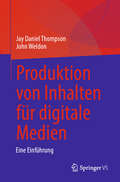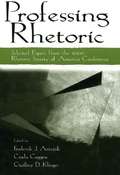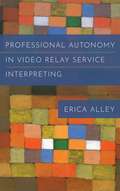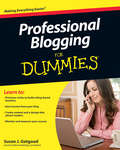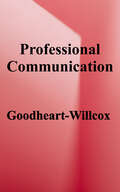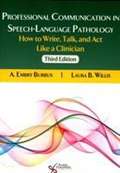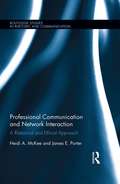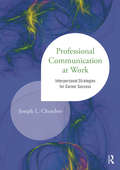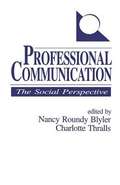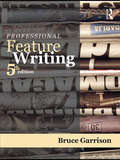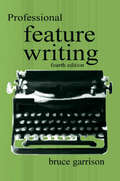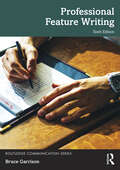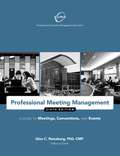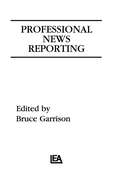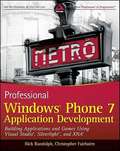- Table View
- List View
Processing interclausal Relationships: Studies in the Production and Comprehension of Text
by Michel Fayol Jean CostermansDuring the last 10 years, more and more linguistic and psycholinguistic research has been devoted to the study of discourse and written texts. Much of this research deals with the markers that underline the connections and the breaks between clauses and sentences plus the use of these markers -- by adults and children -- in the production and comprehension of oral and written material. In this volume, major observations and theoretical views from both sides of the Atlantic are brought together to appeal to a wide range of linguists, psychologists, and speech therapists. The volume presents contributions from researchers interested specifically in adult language and from others concerned with developmental aspects of language. Some contributors deal primarily with production, whereas others concentrate on comprehension. Some direct their attention to oral discourse while others focus on written texts. To preserve overall coherence, however, the contributors were given the following recommendations: * With regard to the level of linguistic analysis, the emphasis should be on the clause level -- more particularly, on the relationships between clauses. * Special emphasis should also be placed on linguistic markers (e.g., connectives, markers of segmentation, punctuation). * An overview of a given field of research should be offered, and current research should be put into perspective. * For contributors in the developmental field, attention should be paid to the fact that an account of the acquisition of some language functions throughout childhood should be included only if general principles of interclause relations that might be masked by the exclusive examination of adult evidence could be derived from it.
Producing Graphic Media for Sports: New Horizons and Possibilities for the Motion Media Specialist
by John S. ZaffutoProducing Graphic Media for Sports: New Horizons and Possibilities for the Motion Media Specialist explores the origins, applications, and future of the production of sports-oriented motion graphics. Beginning with the evolution and development of sports-oriented art and design, this book investigates the importance of motion graphics within a variety of environments in the sphere of organized, competitive activity. Venue-based presentation, broadcast and streaming environments, and the importance of graphic standards and brand guidelines are all discussed in detail, along with applications within social media and mobile platforms. A final chapter on emerging technologies covers the potential use of motion media for e-sports and other trending developments within the sports world. The author draws on case studies and interviews with sports media professionals to augment his own research and observation of trends and processes and to highlight the exciting career opportunities that exist within the sports presentation and marketing industries. This book is recommended reading for students of advanced media production, sports marketing, and media production for advertising.
Producing New and Digital Media: Your Guide to Savvy Use of the Web
by Thomas Kenny James CohenProducing New and Digital Media is your guide to understanding new media, diving deep into topics such as cultural and social impacts of the web, the importance of digital literacy, and creating in an online environment. It features an introductory, hands-on approach to creating user-generated content, coding, cultivating an online brand, and storytelling in new and digital media. This book is accompanied by a companion website--designed to aid students and professors alike--that features chapter-related questions, links to resources, and lecture slides. In showing you how to navigate the world of digital media and also complete digital tasks, this book not only teaches you how to use the web, but understand why you use it. KEY FEATURES For students- a companion site that features research resources and links for further investigation For instructors- a companion site that features lecture slides, a sample syllabus, and an Instructor's Manual. Features a unique approach that covers media studies aspects with production and design tutorials. Covers up-to-date forms of communication on the web such as memes, viral videos, social media, and more pervasive types of online languages.
Producing New and Digital Media: Your Guide to Savvy Use of the Web
by Thomas Kenny James CohenProducing New and Digital Media is your essential guide to understanding new media, taking a deep dive into such topics as the cultural and social impacts of the web, the importance of digital literacy, and creating in an online environment. This cutting edge text provides an introductory, hands-on approach to creating user-generated content, coding, cultivating an online brand, and storytelling in new and digital media. In showing you how to navigate the world of digital media and complete digital tasks, this book not only teaches you how to use the web, but also helps you understand why you use it. Key features for the second edition include: Coverage of up-to-date forms of communication on the web: memes, viral videos, social media, and more pervasive types of online languages. New chapters on YouTube influencers and on-demand subscription television. Each chapter has media literacy sidebars, sample assignments, and activities. Updates to the companion website additional materials for students and instructors Thoughtful, entertaining, and enlightening, this is the fundamental textbook for students of new and digital media, digital culture and media literacy, as well as a useful resource for anyone wanting to understand and develop their presence in our digital world.
Producing Online News: Digital Skills, Stronger Stories
by Ryan M. ThornburgThe dazzling speed of change in online journalism can mask a simple truth: online news is still news. Cutting-edge technology benefits the audience only when journalists apply it in the service of good stories. Building on a foundation of news stories, Producing Online News shows students how to use the right tools to get the right information to the right people at the right time. The goal is to become a full-fledged online news producer and transform stories into a complete news experience for an ever more demanding audience. Ryan Thornburg, a journalism trainer who has managed the websites of top news organizations, hones the skills students need to produce stories using multimedia, interactivity and on-demand delivery- online journalism′s three pillars. Practical instructions show students not just how to use the tools but also how to make good journalistic choices in applying them. The book works for courses specifically in online journalism or for any journalism course that incorporates multiple platforms. Features that make for stronger stories:TOOLS sections walk students through the latest technology- Twitter, Wordpress, Audacity, Caspio, Dipity and more- so their writing gains more immediacy and impact. Real-world examples from both traditional outlets and new-style sites like ProPublica, PolitiFact, BeliefNet and Global Voices showcase journalists connecting with their audiences. View Source boxes uncover the technology behind a specific news project-for example, how do just five editors at Yahoo News publish 2,000 stories a day?News Judgement boxes explore journalistic choices- sure, students can link a story to anything on the web- but should they?
Product Release Planning: Methods, Tools and Applications
by Guenther RuheBusiness success hinges on successfully creating products with the right features. You must correctly analyze the needs of the customer and match these needs with your resources to not only produce a product and but also deliver it in a timely manner. An in-depth understanding of systematic release planning can put you on this path. Authored by ren
Production Management for Television (Media Skills)
by Leslie MitchellCompletely up to date with relevant information on digital technology and HD TV, this is the only title to focus specifically on television production management, and presents an easily accessible and authoritative guide to the area. Production Management for Television provides a reliable, factual and theoretical framework for an understanding of production management. It includes a reference directory of agencies and organizations, and addresses and contacts for training. Subjects covered include: • the main responsibilities of the production manager• key skills needed by the production manager• routine procedures• appropriate paperwork and record keeping• health and safety issues• rights management• career structure and development for production managers• useful references and further information. The book is supported by a companion website at www.routledge.com/textbooks/9780415424813.
Productivity, Professionalism, and Parenting in Academia: Rhet Comp Moms (Routledge Research in Writing Studies)
by Christine E. TulleyDrawing on time use diary analysis, this unique and detailed study fills in the larger narrative about what it takes, hour by hour, to navigate academic motherhood with a rhetoric and composition career.Looking specifically at the intersections between parenting and writing for publication in order to find out how and when writing for career-advancing tasks such as publication occur, but also through the lens of disciplinary time constraints including heavy grading and administrative workloads, the book examines support systems noted within diary entries that make combining motherhood and a career in rhetoric and composition possible. Using both quantitative analysis of hours and qualitative coding of time use diaries from rhet comp moms, this book answers questions about publishing, professionalism, and parenting.This book will interest scholars and graduate students working in the discipline of rhetoric, writing, and composition, particularly those working on labor and professional issues, on gender and equality within the discipline, and anyone working in all fields looking for ways to foster a better work–life balance.
Produktion von Inhalten für digitale Medien: Eine Einführung
by John Weldon Jay Daniel ThompsonDieses Buch bietet eine Einführung in die Produktion digitaler Medieninhalte im einundzwanzigsten Jahrhundert. Dabei werden die Inhalte aus den Berufsfeldern Journalismus, Öffentlichkeitsarbeit und Marketing behandelt. Das Buch gibt einen Einblick, wie Inhalte präsentiert werden und befasst sich mit den rechtlichen und ethischen Fragen, mit denen sich die Produzenten von Inhalten konfrontiert sehen, sowie mit der Frage, wie diese Probleme erfolgreich bewältigt werden können. Die Kapitel enthalten auch Interviews mit Medienfachleuten und Quizfragen, die es den Lesern ermöglichen, das durch die Lektüre des jeweiligen Kapitels erworbene Wissen zu festigen.
Professing Rhetoric: Selected Papers From the 2000 Rhetoric Society of America Conference
by Frederick J. Antczak Geoffrey D. KlingerRepresenting current theory and research in rhetoric, this volume brings together scholarship from a variety of orientations--theoretical, critical, historical, and pedagogical. Some contributions cover work that has previously been silenced or unrecognized, including Native American, African American, Latino, and women's rhetorics. Others explore rhetoric's relationship to performance and to the body, or to revising canons, stases, topoi, and pisteis. Still others are reworking the rhetorical lexicon to comprise contemporary theory. Among these diverse interests, rhetoricians find common themes and share intellectual and pedagogical enterprises that hold them together even as their institutional situations keep them apart. Topics discussed in this collection include: *Rhetoric as figurality; comparative and contrastive rhetorics; rhetoric and gender; and rhetorics of science and technology; *Rhetoric and reconceptions of the public sphere; rhetoric and public memory; and rhetorics of globalization and social change, including issues of race, ethnicity, and nationalism; *Rhetoric's institutionalized place in the academy, in relation to other humanities and to the interpretive social sciences; and *The place of rhetoric in the formation of departments and the development of pedagogy With its origins in the 2000 Rhetoric Society of America (RSA) conference, this volume represents the range and vitality of current scholarship in rhetoric. The conversations contained herein indicate that professing rhetoric is, at the turn of the millennium, an intellectual activity that engages with and helps formulate the most important public and scholarly questions of today. As such, it will be engaging reading for scholars and students, and is certain to provoke further thought, discussion, and exploration.
Professional Autonomy in Video Relay Service Interpreting (Gallaudet Studies In Interpret #17)
by Erica AlleyVideo relay service (VRS) is a federally funded service that provides telecommunications access for deaf people. It is also a for-profit industry with guidelines that may limit the autonomy of the sign language interpreters who work in VRS settings. In this volume, Erica Alley examines how VRS interpreters, or “Communication Assistants,” exercise professional autonomy despite the constraints that arise from rules and regulations established by federal agencies and corporate entities. Through interviews with VRS interpreters, Alley reveals the balance they must achieve in providing effective customer service while meeting the quantitative measures of success imposed by their employer in a highly structured call center environment. Alley considers the question of how VRS fits into the professional field of interpreting, and discovers that—regardless of the profit-focused mentality of VRS providers—interpreters make decisions with the goal of creating quality customer service experiences for deaf consumers, even if it means “breaking the rules.” Her findings shed light on the decision-making process of interpreters and how their actions are governed by principles of self-care, care for colleagues, and concern for the quality of services provided. Professional Autonomy in Video Relay Service Interpreting is essential reading in interpreter education courses and interpreter training programs.
Professional Blogging For Dummies
by Susan GetgoodTake your hobby to the next level and turn your blog into real income Anyone who blogs knows that it is a fun, creative way for sharing thoughts and opinions. Now imagine making money from that hobby! This practical, how-to guide shows you how you can get serious about using your blog and implement advertising, sponsorship, partnerships, and affiliate marketing options to turn your hobby into extra income, or even a full-time career. Helpful examples and featured articles with topic experts and bloggers who have built successful business demonstrate how to promote your business or build a blog-based business. Discusses finding your niche, adhering to legal considerations, establishing your disclosure and privacy policies, and dealing responsibly with review requests Introduces ideas for advertising and other monetization options and recommends promotional avenues to explore Suggests creative ways to keep your blog fresh, unique, and interesting Provides tips for monitoring and measuring your success Professional Blogging For Dummies opens the door to a world of money-making blogging possibilities!
Professional Communication
by Goodheart-Willcox PublisherThis book takes an integrated approach to teaching English/language arts skills that are vitally important in today's digital environment. The basic skills of writing, speaking, listening, and reading are interwoven into the content as each skill is presented and applied in context. <p><p>Students are guided through a step-by-step writing process to create clear and concise messages and develop professional skills that are that are sought after in the workplace. Topics such as making presentations, grammar basics, and digital citizenship prepare students for success in college and career and to become effective contributors in the 21st century. <p><p>Writing for specialized purposes, such as technical writing and social media, guides the development of writing expertise needed in today's job market. Portfolio development activities provide an opportunity for students to create a personal portfolio to use when applying for college, a community service position, or a job. <p><p>Exploring Communication Careers features examine a wide variety of opportunities in the Arts, A/V Technology and Communication career cluster. Career planning chapters help students to prepare, apply, and begin the first day on a job.
Professional Communication In Speech-Language Pathology: How To Write, Talk, And Act Like A Clinician
by Laura Willis A. BurrusIn Professional Communication in Speech-Language Pathology: How to Write, Talk, and Act Like a Clinician, Third Edition, the authors introduce student clinicians to the various types of written and verbal communication they will encounter across three different clinical settings: university clinics, medical settings, and public schools. The text is written in a student-friendly manner, with appendices that provide examples of correspondence, diagnostic and treatment reports, data sheets, and important acronyms in medical and school settings. Chapters cover verbal interactions with families, allied professionals, and supervisors, as well as written communication across the university, medical, and school settings. Also included are scenarios written in the form of vignettes that address issues of ethics, interviewing, and procedures for managing protected health information.
Professional Communication and Network Interaction: A Rhetorical and Ethical Approach (Routledge Studies in Rhetoric and Communication)
by James E. Porter Heidi A. McKeeDigital technologies and social media have changed the processes, products, and interactions of professional communication, reshaping how, when, with whom, and where business professionals communicate. This book examines these changes by asking: How does rhetorical theory need to adapt and develop to address the changing practices of professional communication? Drawing from classical and contemporary rhetorical theory and from in-depth interviews with business professionals, the authors present a case-based approach for exploring the changing landscape of professional communication. The book develops a rhetorical theory based on networked interaction and rhetorical ethics: seeing professional communication as involving new kinds of networked interactions that require an integrated view of rhetoric and ethics. The book applies this frame to a variety of communication cases involving, for example, employee missteps on social media, corporate-consumer interactions, and the developing use of artificial intelligence agents (AI bots) to handle online communication.
Professional Communication at Work: Interpersonal Strategies for Career Success
by Joseph L. ChesebroThis text prepares future professionals for success in the workplace through identifying interpersonal communication skills and strategies and exploring when, how, and why to use them. Informed by academic research, professional literature, and author Joseph L. Chesebro’s own experiences, the text explores and demonstrates the skills that have facilitated Chesebro’s own students to find work and to succeed in their professional lives. Offering a very practical focus on such topics as handling conflict and giving dynamic presentations, Professional Communication at Work also covers essential interpersonal communication skills that are often not discussed, such as: Using networking when job hunting; Earning a good reputation as a new employee Using storytelling and questioning more often Developing coaching relationships with the best senior employees in our workplace, Practicing and developing new skills on our own, and Using workplace politics in a positive and constructive way to accomplish our goals. Utilizing the approach of a supportive communication coach, this text will help readers gain a variety of practical communication strategies they can apply to contribute to success in their own careers.
Professional Communication: The Social Perspective
by Nancy Roundy Blyler Charlotte ThrallsThis volume examines socially-based theory and research, pedagogy and practice in professional communication. The contributors provide a comprehensive overview of the social perspective which emphasizes the context of communication, and then distinguish it from positivistic, cognitive and other competing approaches. After establishing a broad framework for situating developments in professional communication research, the book then moves on to: explore more particular topics, issues and problems within the perspective; examine the historical and theoretical traditions in rhetoric, semiotics, literary criticism, philosophy of science, social psychology and cultural anthropology; discuss implications for classroom practice in professional communications.
Professional Discourse
by Kenneth KongUsing a wide range of professional genres such as research papers, business reports, performance commentaries, guidebooks and legal documents, this study focuses on the discourse of professional writing, employing analytic paradigms from systemic-functional linguistics, pragmatics, text analysis, sociology and anthropological linguistics. Kenneth Kong argues that while professions use different sets of practices, their use of language displays many universals. This is demonstrated through the analysis of data from a broad cross-section of professional settings such as medicine, law, business, mass media and engineering. This examination of professional discourse, and its important role in society, will be of interest to researchers in applied linguistics, to professionals who want to understand the role of language in their work, and to teachers of English for specific purposes.
Professional Feature Writing
by Bruce GarrisonProfessional Feature Writing provides the basics of news media feature writing and establishes a solid foundation for students and writers making feature writing their career. This fifth edition offers a thorough and up-to-date look at newspaper, magazine, newsletter, and online publications, with emphasis on daily newspapers and consumer magazines. It serves as a comprehensive introduction to feature writing, emphasizing writing skills, article types, and the collegiate and professional writing life. With a wide variety of perspectives and experiences of both young and experienced writers, editors, publishers, and professors, the text is filled with practical guidance for writing a wide variety of features. Emphasizing writing values to strengthen a new writer's journalistic practices, author Bruce Garrison offers insights and expertise based on his own experience and the advice of professionals. He also includes lists of tips, observations, guidelines, sources, and story ideas, and gives a solid tour of the forms and approaches to feature writing. New for this edition are: Updated examples of feature writing, integrated throughout the text Profiles of young newspaper and magazine feature writers, highlighting their experiences and paths to success in the profession Coverage of computer-based research tools for writers, including discussion of on-line computer-based research tools with specific focus on the World Wide Web Discussion of online newspapers, magazines, newsletters, and original online publications and the role of feature writing for electronic publications. Each chapter includes excerpts and complete articles from the nation's leading publications. Building on introductory writing and reporting skills, this text is appropriate for upper-division journalism students learning feature writing and advanced writing topics. It will also serve as a valuable resource for freelance writers.
Professional Feature Writing
by Bruce GarrisonThis text offers the basics of news media feature writing and guides motivated beginners down the right path toward success as professional feature writers. This fourth edition gives advanced writers and reporters a thorough look at newspaper, magazine, newsletter, and online publications, with emphasis on daily newspapers and consumer magazines. Three primary aspects of feature writing are emphasized: introduction and writing skills/basics, article types, and the collegiate and professional writing life. Each chapter includes excerpts and complete articles from some of the nation's leading publications that illustrate points made in the text. Professional Feature Writing provides a wide variety of perspectives and experiences of both young and experienced writers, editors, publishers, and professors. Emphasizing writing values that will strengthen a new writer's journalistic practices, readers will gain insights and expertise from the narrative, the advice of professionals, and current writing examples. The book offers lists of tips, observations, in-depth looks at both young and veteran writers, guidelines, sources, and story ideas. As such, this volume is a solid tour of the forms and approaches to feature writing. Building on introductory writing and reporting skills, this text is written for advanced students, and is filled with practical advice for writing a wide variety of features.
Professional Feature Writing (Routledge Communication Series)
by Bruce GarrisonProfessional Feature Writing provides an essential introduction to the basics of news media feature writing and establishes a solid foundation for students and writers making feature writing their careers. This sixth edition offers a thorough and up-to-date look at newspapers, magazines, newsletters, and online publications, with emphasis on daily newspapers, consumer magazines, and online news. Special attention is paid to writing skills, feature story types, and the collegiate and professional writing life, and the text is filled with practical guidance for writing a wide variety of features, drawing on insights from both junior and experienced writers, editors, and publishers. Alongside a solid tour of forms and approaches to feature writing, the author includes lists of tips, observations, guidelines, sources, and story ideas. New to this edition are: Three chapters covering interviewing and observation in features, social media in feature writing, and writing social trends features; Updated international examples of feature writing, integrated throughout the text; Additional and expanded discussion about writing features for online publications and the uses of social media in gathering information and reporting; Increased attention to multimedia and the impact of new technologies on the industry. Building on introductory writing and reporting skills, this text is appropriate for upper-division journalism students learning feature writing and advanced writing topics. It will also serve as a valuable resource for freelance writers.
Professional Meeting Management: A Guide To Meetings, Conventions And Events
by Professional Convention Management Association StaffThe sixth edition of Professional Meeting Management is the newest edition of the longtime standard reference and textbook for the meetings industry and meetings education. This is the first student and meeting professionals textbook aligned with the new Certified Meeting Professional (CMP) International Standards, which will be used by the Convention Industry Council as a reference book for item writing for the CMP Certification Examination. It includes the most up-to-date information on current trends, strategic planning for meetings, budgeting and funding, marketing and promotion, technology, running and closing the meeting, and industry developments on the horizon.
Professional News Reporting (Routledge Communication Series)
by Bruce GarrisonBecause reporting is changing, this volume offers readers a thorough introduction to the rapidly evolving world of gathering information for local news organizations. This easy-to-read text is filled with contemporary examples and solid advice for the beginning reporting student. Designed for students with a foundation in news writing, it provides chapters on such basics as news research, interviewing, and observation skills. It further offers a chapter on the use of personal computers as research and reporting tools. Readers will find useful tips and examples written by award-winning professional journalists that reflect the numerous changes in the art and science of information gathering in the past decade.
Professional Windows Phone 7 Application Development
by Nick Randolph Christopher FairbairnA one-of-a-kind book on Windows Phone 7 developmentWhile numerous books cover both Silverlight and XNA, there lacks a resource that covers the specifics of Windows Phone 7 development. This book fills that void and shares the specifics of building phone applications and games. You'll learn how to get started with designing, building, testing, and deploying mobile applications for Windows Phone 7. Working examples used throughout the book cover how to design and layout a Windows Phone 7 application, interact with the device, and even sell your applications.Fills the void in the market for an instructional book on developing applications for Windows Phone 7Offers an overview of Windows Phone and discusses the necessary toolsExplains how to work with multiview applicationsAddresses tool bars, pickers, table views, navigation controllers, application setting, and user defaultsReviews drawing with XNA, using the camera, and understanding basic data persistenceExplore the exciting possibilties of Windows Phone 7 development with this invaluable reference.
